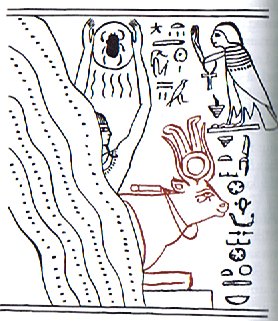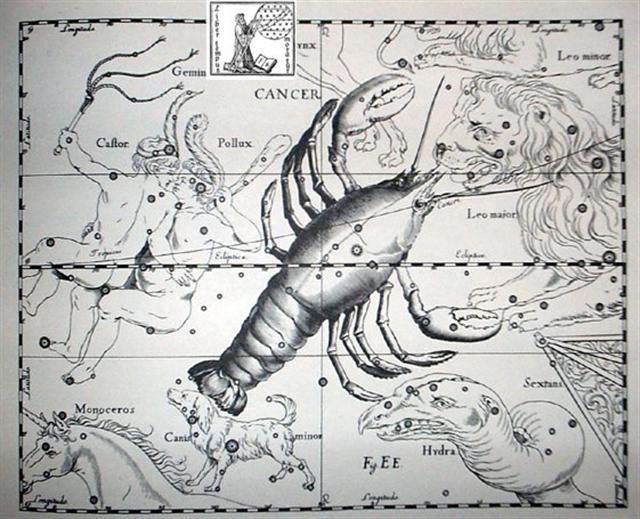|
4. We can guess why 'three nebulous objects' were imagined to be in M44 - the cooking pot needs 3 stones to rest on. The turtle below Orion was also a fire place:
"Jensen makes it [Cancer] the Tortoise of Babylonia, and it was so figured there and in Egypt 4000 B.C.; although in the Egyptian records of about 2000 B.C. it was described as a Scarabaeus, sacred, as its specific name sacer signifies, and an emblem of immortality. This was the Greek κάραβος, with its nestball of earth in its claws, an idea which occurs again even as late as the 12th century, when an illuminated astronomical manuscript shows a Water-beetle." (Allen) I think the Water Beetle must be the Cancer garment of Sun. Mercury is the only liquid planet and water is an aspect of Sun. Once upon a time, a very long time ago, when the Sun baby emerged at spring equinox and was uplifted from the waters of winter it was a time determined by his mother (Hathor, the 'lady of every joy'):
... In the inscriptions of Dendera, published by Dümichen, the goddess Hathor is called 'lady of every joy'. For once, Dümichen adds: Literally ... 'the lady of every heart circuit'. This is not to say that the Egyptians had discovered the circulation of the blood. But the determinative sign for 'heart' often figures as the plumb bob at the end of a plumb line coming from a well-known astronomical or surveying device, the merkhet. Evidently, 'heart' is something very specific, as it were the 'center of gravity' ... See Aeg.Wb. 2, pp. 55f. for sign of the heart (ib) as expressing generally 'the middle, the center'. And this may lead in quite another direction. The Arabs preserved a name for Canopus - besides calling the star Kalb at-tai-man ('heart of the south') ... Suhail el-wezn, 'Canopus Ponderosus', the heavy-weighing Canopus, a name promptly declared meaningless by the experts, but which could well have belonged to an archaic system in which Canopus was the weight at the end of the plumb line, as befitted its important position as a heavy star at the South Pole of the 'waters below'. Here is a chain of inferences which might or might not be valid, but it is allowable to test it, and no inference at all would come from the 'lady of every joy'. The line seems to state that Hathor (= Hat Hor, 'House of Horus') 'rules' the revolution of a specific celestial body - whether or not Canopus is alluded to - or, if we can trust the translation 'every', the revolution of all celestial bodies. As concerns the identity of the ruling lady, the greater possibility speaks for Sirius, but Venus cannot be excluded; in Mexico, too, Venus is called 'heart of the earth'. The reader is invited to imagine for himself what many thousands of such pseudo-primitive or poetic interpretations must lead to: a disfigured interpretation of Egyptian intellectual life ... The rounded outline of a crab, with a carapace above ('sky', Ç) and a carapace below ('water', È) - and a living creture in between ('earth') - was a good model to have as an illustration when trying to describe what happens at spring equinox. When precession later moved Cancer away it would be more fitting to put another crustacean in the position of Cancer, for instance a Lobster. Much later the flounder who hid in the mud (the Milky Way) could compete with the Lobster. At a solstice the path of Sun is flat, therefore a flatfish. The idea of 'hidden' to illustrate the mysterious beginning is the basic theme of the story about Lobster and Flounder. Even though the stars in M44 are very difficult to see the 'feelers' makes it possible to find where they are hiding. The 'mud' of the Milky Way is a better place to hide in. In the picture of Hevelius the feelers of the Lobster are drawn on either side of the Leo head:
So we should wait until next right ascension hour to complete the discussion about Cancer. |


